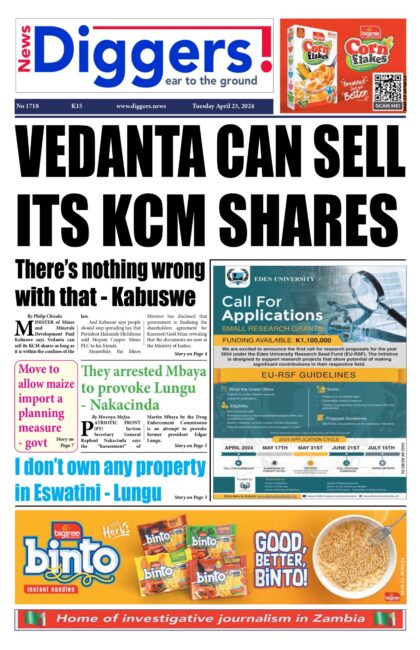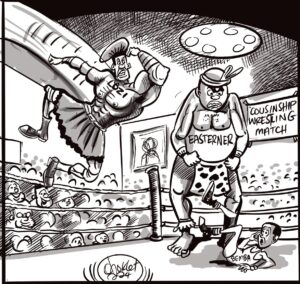Government, through the Bank of Zambia (BoZ), will buy and collect more than 40,000 kilogrammes of gold from primary and secondary sources, including artisanal and small-scale gold miners, Mines Permanent Secretary Barnaby Mulenga has announced.
And ZCCM-IH chief executive officer Mabvuto Chipata has disclosed that the institution has embarked on a programme to set up gold-buying centres in strategic panning areas.
Speaking during a press briefing in Lusaka, Thursday, Mulenga said the government was in dire need of liquid cash and that as such, gold mining licenses of companies that had not yet commenced operations would be revoked.
“The information generated will facilitate delineation of areas into gold panning, artisanal, small or large-scale. Large-scale areas will be reserved for government to license. On the other hand, reserves and river beds will be allocated or licensed to panners and artisan miners. Revoking non-compliant licenses in the targeted areas in public interest pursuant to section 72 (l) (i) of the Mines and Minerals Development Act of 2015. We need the money, as government, so what are they waiting for? Those who have not commenced operations will lose their licences,” Mulenga cautioned.
“Compelling existing small and large-scale mining companies to account for the gold from their mining operations, implementing measures to curb illegal exploitation of gold and means of accounting for the gold to raise revenue for the government. Other measures include: sensitization of local communities to ensure success of the strategy. The strategy requires a multi-sectoral approach to ensure that all ministries cooperate to account for the gold. The target amount of gold to be collected, as we’ve said by 2020, is 40,000Kgs. And this will come from primary sources and secondary sources that include artisanal and small-scale gold miners. And this is achievable through a well-coordinated approach; that is why we have mandated ZCCM-IH to drive this strategy, working with various partners and stakeholders.”
He said Zambia currently had more than 21 districts with deposits of gold at varying quantities.
“There are currently 21 districts with active gold mining activities, which include: Solwezi; Mwinilunga; Kasempa; Mumbwa; Kabwe; Chisamba; Senga Hills; Mpika; Chilanga; Chadiza; Chirundu; Kazungula; Lundazi; Chongwe; Petauke; Lusangazi; Vubwi; Luano; Rufunsa; Chipata; Mkushi and Serenje. More and more districts are discovering that there is gold in their areas because Zambia is not full or 100 per cent geologically mapped, but rather stands at about 62 per cent,” said Mulenga.
“Computation of estimates of the gold that could be bought off/collected can only be realized with an aggressive approach towards harnessing the artisanal miners in Zambia. We also want our people to derive value from their hard work and not the manner in which they are being exploited by unscrupulous people. This approach will help uplift the living standards of our people, who are currently panning for gold, and improve their local economies in a sustainable and environmentally friendly manner. And that’s where ZCCM-IH comes in.”
And Chipata said the institution was in the process of forming a Special Purpose Vehicle (SPV) that would oversee the operations of all gold-related operations.
He outlined that ZCCM-IH had since embarked on a programme to set up gold-buying centres in strategic panning areas.
“We are in the process of forming a Special Purpose Vehicle that will oversee and undertake all gold-related projects. The name of this vehicle is yet to be announced. Once these results are out, we will continue with the exploration programme, particularly for the primary source of the gold in Kasenseli. This exploration for primary gold source will be happening in tandem with preparatory works for us to commence mining within 2020 once statutory approvals are finalized. Second, as one of the steps towards the formalization of the artisanal and small-scale gold miners. ZCCM-IH has embarked on a programme to set-up gold buying centres in strategic gold panning areas. We have since obtained a mineral trading permit to this effect to enable us carry out this programme. The initial sites include: Rufunsa; Vubwi; Luano; Petauke; Senga Hill and Mumbwa, and will be rolled out to other areas in the country with gold occurrences,” Chipata explained.
He added that ZCCM-IH was working in collaboration with the Ministry of Mines to formalize artisanal gold mines with the objective of curbing illegal mining activities.
“The main objective is to curb the smuggling of gold out of the country; provide an open market and competitive prices for the artisanal gold miners, and ultimately, take stock of the gold output from artisanal miners. Third, aside from this gold-buying programme, we are also working towards formalization of artisanal gold miners in collaboration with the Ministry of Mines and other stakeholders…So far, cooperatives have been registered in some areas such as Rufunsa and Petauke, and these will be given artisanal licences within the licence areas to be granted and managed by ZCCM-IH. As you have witnessed already, there has been a lot of environmental damage in gold panning and mining areas. So, the first step will be to undertake some environmental remediation exercise and this will be done through our environmental and technical services subsidiary, Misenge. We will further provide technical expertise to the artisanal gold miners with regards to mine planning, safety, among others,” said Chipata.













One Response
This seems like great news, gold and silver are required if the kwatcha is to strengthen – and by god it needs strengthening.